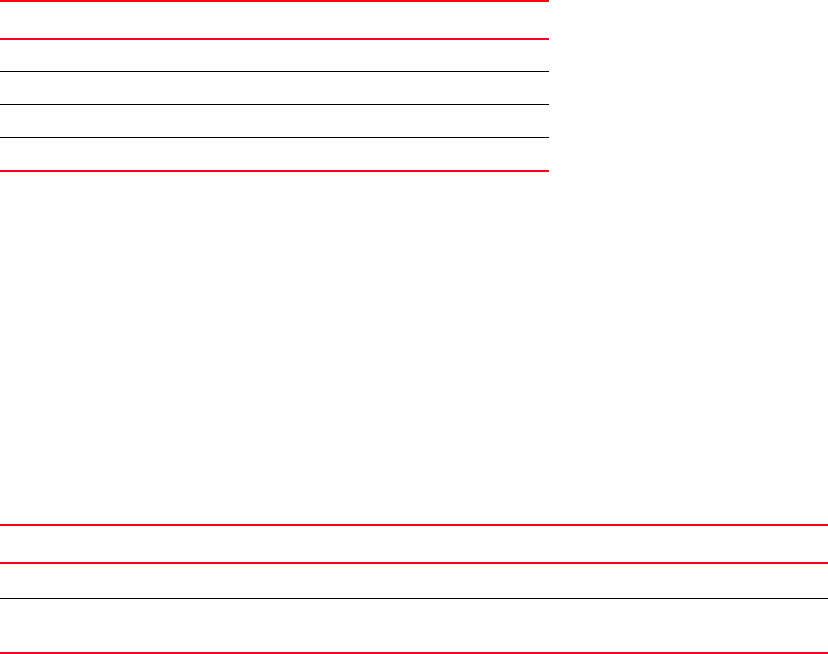Brocade Converged Enhanced Ethernet Administrator's Guide v6.1.2_cee (53-1001258-01, June 2009)
Table Of Contents
- Contents
- Figures
- Tables
- About This Document
- Introducing FCoE
- Using the CEE CLI
- In this chapter
- CEE CLI configuration guidelines and restrictions
- Using the CEE command line interface (CLI)
- CEE CLI RBAC permissions
- Accessing the CEE CLI through the console interface or through a Telnet session
- Accessing the CEE CLI from the Fabric OS shell
- Accessing CEE CLI command modes
- Using CEE CLI keyboard shortcuts
- Displaying CEE CLI commands and command syntax
- Using CEE CLI command completion
- CEE CLI command syntax conventions
- Using CEE CLI command output modifiers
- Configuring VLANs Using the CEE CLI
- In this chapter
- VLAN overview
- Ingress VLAN filtering
- VLAN configuration guidelines and restrictions
- Default VLAN configuration
- VLAN configuration procedures
- Enabling and disabling a CEE interface
- Configuring the MTU on a CEE interface
- Creating a VLAN interface
- Configuring a VLAN interface to forward FCoE traffic
- Configuring a CEE interface as a Layer 2 switch port
- Configuring a CEE interface as an access interface or a trunk interface
- Configuring VLAN classifier rules
- Configuring VLAN classifier groups
- Associating a VLAN classifier group to a CEE interface
- Clearing VLAN counter statistics
- Displaying VLAN information
- Configuring the MAC address table
- Configuring STP, RSTP, and MSTP using the CEE CLI
- In this chapter
- STP overview
- RSTP overview
- MSTP overview
- STP, RSTP, and MSTP configuration guidelines and restrictions
- Default STP, RSTP, and MSTP configuration
- STP, RSTP, and MSTP configuration procedures
- STP, RSTP, and MSTP-specific configuration procedures
- STP and RSTP-specific configuration procedures
- RSTP and MSTP-specific configuration procedures
- MSTP-specific configuration procedures
- 10-Gigabit Ethernet CEE interface-specific configuration
- Global STP, RSTP, and MSTP-related configuration procedures
- Clearing STP, RSTP, and MSTP-related information
- Displaying STP, RSTP, and MSTP-related information
- Configuring Link Aggregation using the CEE CLI
- Configuring LLDP using the CEE CLI
- Configuring ACLs using the CEE CLI
- In this chapter
- ACL overview
- Default ACL configuration
- ACL configuration guidelines and restrictions
- ACL configuration procedures
- Creating a standard MAC ACL and adding rules
- Creating an extended MAC ACL and adding rules
- Modifying a MAC ACL
- Removing a MAC ACL
- Reordering the sequence numbers in a MAC ACL
- Applying a MAC ACL to a CEE interface
- Applying a MAC ACL to a VLAN interface
- Clearing MAC ACL counters
- Displaying MAC ACL information
- Configuring QoS using the CEE CLI
- Configuring FCoE using the Fabric OS CLI
- Administering the switch
- Configuring RMON using the CEE CLI
- Index

Converged Enhanced Ethernet Administrator’s Guide 117
53-1001258-01
Scheduling
8
Multicast queue scheduling
The multicast traffic classes are numbered from 0 to 3; higher numbered traffic classes are
considered higher priority. A fixed mapping from multicast traffic class to equivalent unicast traffic
class is applied to select the queue scheduling behavior. Table 21 presents the multicast traffic
class equivalence mapping applied.
Once the multicast traffic class equivalence mapping has been applied, then scheduling and any
scheduler configuration are inherited from the equivalent unicast traffic class. For example, with
an SP8 scheduling policy, multicast traffic class 3 is mapped to unicast traffic class 6 and referring
to Table 20 on page 116 shows it will inherit SP7 scheduling priority and multicast traffic class 2
inherits SP5 service, 1 = SP3, 0 = SP1. And SP4 scheduling policy multicast traffic class 3 inherits
SP3 service, 2 = SP1, 1 = WRR3, 0 = WRR1.
Unicast ingress and egress queueing utilizes a hybrid scheduler that simultaneously supports
SP+WRR service and multiple physical queues with the same service level. Multicast adds
additional multicast expansion queues. Since multicast traffic classes are equivalent to unicast
service levels, they're treated exactly as their equivalent unicast service policies.
Scheduling the QoS multicast queue
Example of setting the multicast Traffic Class packet expansion scheduler for Traffic Class 0 getting 10% bandwidth, Traffic
Class 1 getting 20% bandwidth, Traffic Class 2 getting 30% bandwidth, and Traffic Class 3 getting 40% bandwidth.
switch:admin>cmsh
switch>enable
switch#configure terminal
Enter configuration commands, one per line. End with CNTL/Z.
switch(config)#qos queue multicast scheduler dwrr 10 20 30 40
switch(config)#exit
switch#
TABLE 21 Multicast traffic class equivalence mapping
Multicast traffic class Equivalent unicast traffic class
36
24
12
00
Step Task Command
1 Enter global configuration mode.
switch#configure terminal
2 Specify the schedule to use and the traffic
class to bandwidth mapping.
switch(config)#qos queue multicast
scheduler dwrr 10 20 30 40










